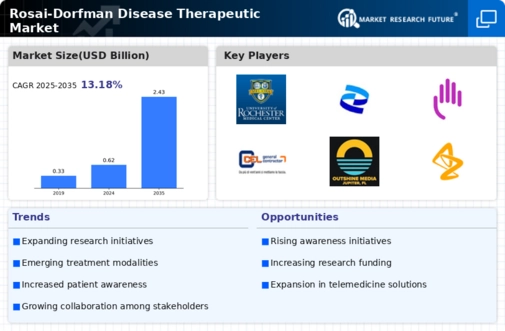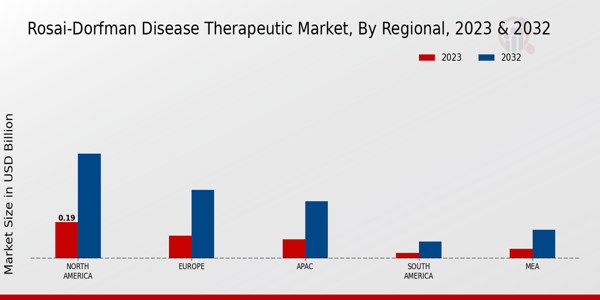Market Growth Projections
The Global Rosai-Dorfman Disease Therapeutic Market Industry is projected to experience substantial growth over the next decade. With an estimated market size of 0.62 USD Billion in 2024, it is anticipated to reach 2.43 USD Billion by 2035. This growth trajectory reflects a compound annual growth rate (CAGR) of 13.24% from 2025 to 2035. Such projections indicate a robust demand for effective therapeutic options as the understanding of the disease improves and treatment modalities advance. The market's expansion is likely to be driven by a combination of factors, including increased incidence, advancements in treatment, and supportive regulatory frameworks.
Rising Awareness and Advocacy
The rise in awareness and advocacy for rare diseases, including Rosai-Dorfman Disease, plays a pivotal role in shaping the Global Rosai-Dorfman Disease Therapeutic Market Industry. Patient advocacy groups are increasingly active in promoting education and awareness, which helps in early diagnosis and treatment. This heightened awareness can lead to increased patient enrollment in clinical trials, thereby facilitating the development of new therapies. As the market evolves, the collective efforts of these organizations are likely to contribute to a more informed patient population, ultimately driving demand for innovative therapeutic solutions.
Advancements in Treatment Modalities
Innovations in treatment modalities are significantly shaping the Global Rosai-Dorfman Disease Therapeutic Market Industry. Recent developments in targeted therapies and immunotherapies offer promising avenues for effective management of the disease. For instance, the introduction of monoclonal antibodies and novel agents has shown potential in clinical trials, enhancing patient outcomes. As these therapies gain traction, they are expected to contribute to market growth, with projections indicating a market size of 2.43 USD Billion by 2035. The ongoing research and development efforts in this area suggest a robust pipeline of therapeutic options that could transform treatment paradigms.
Regulatory Support for Drug Development
Regulatory bodies are providing enhanced support for the development of therapies targeting rare diseases, which positively impacts the Global Rosai-Dorfman Disease Therapeutic Market Industry. Initiatives such as orphan drug designations and expedited review processes are designed to encourage pharmaceutical companies to invest in research and development for rare conditions. This regulatory environment fosters innovation and can lead to faster access to new treatments for patients. As the market continues to evolve, this supportive framework is expected to facilitate the introduction of novel therapies, thereby expanding the therapeutic landscape for Rosai-Dorfman Disease.
Growing Investment in Rare Disease Research
The Global Rosai-Dorfman Disease Therapeutic Market Industry benefits from increasing investments in research focused on rare diseases. Governments and private organizations are recognizing the need for dedicated funding to explore the underlying mechanisms and potential treatments for conditions like Rosai-Dorfman Disease. This financial support is crucial for fostering innovation and accelerating the development of new therapies. As a result, the market is expected to experience a compound annual growth rate (CAGR) of 13.24% from 2025 to 2035. This influx of resources is likely to enhance the understanding of the disease and lead to the discovery of effective treatment options.
Increasing Incidence of Rosai-Dorfman Disease
The Global Rosai-Dorfman Disease Therapeutic Market Industry is witnessing a rise in the incidence of Rosai-Dorfman Disease, which is a rare disorder characterized by an overproduction of histiocytes. This increase in cases necessitates the development of effective therapeutic options. As awareness grows and diagnostic techniques improve, more patients are being identified, thereby expanding the market. The projected market size for 2024 is estimated at 0.62 USD Billion, indicating a growing demand for targeted therapies. This trend is likely to continue as healthcare providers seek to address the needs of this patient population.













